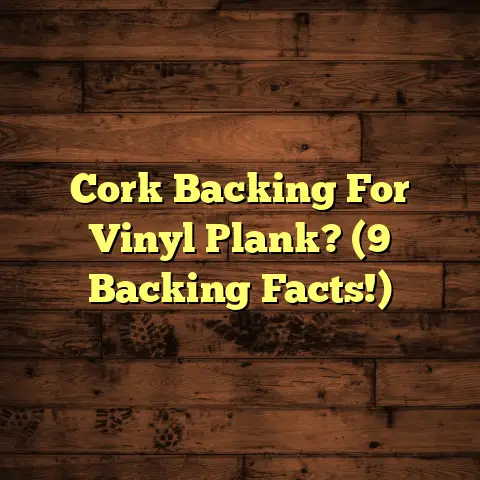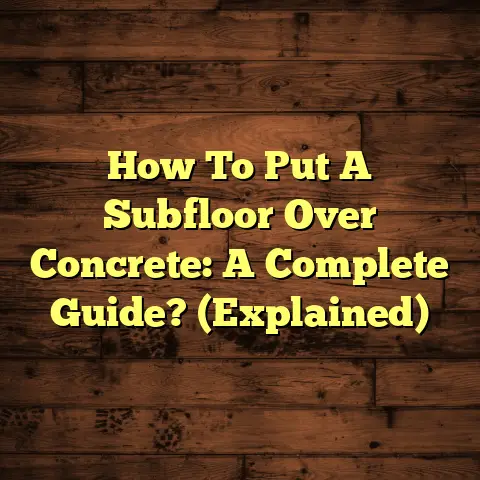How Much Is Waterproof Laminate Flooring? (Explained)
Understanding Waterproof Laminate Flooring
Waterproof laminate flooring is a synthetic product made to replicate the look of hardwood or stone flooring while offering enhanced durability against moisture. Unlike traditional laminate, which can swell and warp when exposed to water, waterproof laminate features an advanced water-resistant core that helps protect against spills and humidity.
The Composition of Waterproof Laminate
The construction of waterproof laminate typically involves several layers:
- Wear Layer: This top layer provides protection against scratches, stains, and fading. It is crucial for maintaining the floor’s appearance over time.
- Design Layer: Below the wear layer, this layer contains a high-resolution photograph of wood or stone, giving it a realistic look.
- Core Layer: The core is made from high-density fiberboard (HDF) that has been treated to resist moisture. This is where waterproof laminate stands out from traditional options.
- Backing Layer: This layer adds stability and acts as a moisture barrier, preventing water from seeping through to the underlayment or subfloor.
I remember when I was researching these layers; understanding their composition helped me appreciate the technology behind waterproof laminate flooring. It gave me confidence that I was making a sound investment for my home.
The Cost Breakdown of Waterproof Laminate Flooring
When considering how much waterproof laminate flooring costs, it’s essential to look at both material and installation expenses. Here’s a more detailed breakdown:
Material Costs
The price of waterproof laminate varies significantly based on brand and quality. Here are some general price ranges I encountered during my research:
- Entry-Level Options: $2 – $3 per square foot. These are typically basic designs with fewer features and shorter warranties.
- Mid-Range Options: $3 – $4 per square foot. These products often have better durability, more realistic designs, and longer warranties.
- High-End Options: $4 – $5 or more per square foot. These offer premium aesthetics, thicker wear layers, and advanced features such as enhanced water resistance.
For my kitchen project, I opted for a mid-range option priced at $3.50 per square foot, which provided a good balance between cost and quality.
Installation Costs
Installation costs can also vary based on whether you choose to do it yourself or hire a professional. If you decide to go the DIY route, you can save on labor costs but may need to invest in tools like a miter saw, tapping block, and spacers.
- Professional Installation: $1 – $3 per square foot. I found that hiring professionals can save time and ensure a flawless finish.
- DIY Installation: Free if you already own the necessary tools, but consider the value of your time and effort.
For my project, hiring a professional for installation cost me around $400 for 200 square feet, which felt worth it to avoid potential mistakes.
Personal Experiences: Successes and Challenges
Reflecting on my journey with waterproof laminate flooring brings back memories of both triumphs and hurdles. Here are some significant moments:
Success Story: Transforming My Kitchen
The most rewarding experience was witnessing the transformation of my kitchen space. I chose a natural oak design that complemented my cabinetry beautifully. The installation took about two days, and once completed, it felt like a new room. Friends and family commented on how stunning it looked, and I could finally relax knowing that it could handle whatever spills came its way.
Challenges Faced: Installation Hiccups
However, not everything went smoothly. During installation, I faced challenges with uneven subflooring. The contractor pointed out that some areas were slightly higher than others, which could lead to problems down the line. To resolve this, we had to use leveling compound in those areas, adding an extra day to the project timeline.
Comparing Options: Waterproof Laminate vs. Other Flooring Types
When deciding on flooring, I explored various options beyond waterproof laminate. Here’s how they compare:
Waterproof Laminate vs. Luxury Vinyl Plank (LVP)
- Appearance: LVP often has a softer feel and is available in a wider range of textures and colors.
- Durability: Both are durable, but LVP may be slightly more resistant to dents due to its flexible nature.
- Cost: LVP usually starts at a higher price point than laminate. My research showed LVP ranging from $3 to $7 per square foot.
I ultimately preferred the look of laminate for my kitchen but appreciated LVP’s versatility for other areas of my home.
Waterproof Laminate vs. Traditional Hardwood
- Aesthetics: Hardwood has an unparalleled natural beauty that many prefer.
- Moisture Resistance: Hardwood can warp or stain if exposed to moisture over time, while waterproof laminate stands up well against spills.
- Cost: Hardwood can range from $5 to $15 per square foot plus installation, making it significantly more expensive than laminate.
While I love the look of hardwood, I couldn’t justify the cost and maintenance needs for my busy home environment.
Installation Tips for Waterproof Laminate Flooring
Based on my experiences, here are some essential installation tips:
Preparing the Subfloor
Before installation begins, ensure your subfloor is clean, dry, and level:
- Cleaning: Remove all debris and dust.
- Leveling: Use a leveling compound for any uneven sections.
- Moisture Testing: Conduct a moisture test if installing in basements or near water sources.
Acclimating the Planks
Letting the planks acclimate is critical for preventing future issues:
- Timing: Place the planks in the installation area for at least 48 hours before starting.
- Temperature: Ensure the room temperature is between 60°F and 80°F during acclimation.
Installation Process
- Underlayment: Lay down a moisture-resistant underlayment if required by the manufacturer.
- Plank Orientation: Decide on plank orientation based on room shape; running them parallel to the longest wall typically looks best.
- Expansion Gaps: Use spacers to maintain expansion gaps around walls and fixed objects.
By following these steps, I managed to avoid common pitfalls that could lead to issues later on.
Maintenance of Waterproof Laminate Flooring
Maintaining waterproof laminate flooring is straightforward but essential for longevity:
Regular Cleaning
I’ve found that regular cleaning keeps the floors looking fresh:
- Daily Care: Sweep or vacuum regularly to prevent dirt buildup.
- Weekly Cleaning: Use a damp mop with a gentle cleaner designed for laminate floors.
Spot Cleaning
For spills:
- Blot immediately with a soft cloth.
- Avoid using excessive water; just dampen the cloth as needed.
Preventative Measures
To avoid scratches:
- Place mats at entryways to catch dirt.
- Use furniture pads under legs to protect against indentations.
Advantages and Disadvantages of Waterproof Laminate Flooring
Here’s an expanded view of the pros and cons based on my insights:
Advantages
- Water Resistance: Ideal for kitchens, bathrooms, and basements.
- Cost Efficiency: Generally cheaper than hardwood or LVP.
- Easy Installation: Many products feature click-lock systems for DIY enthusiasts.
- Variety of Designs: Available in various styles that mimic wood or stone.
Disadvantages
- Limited Lifespan: While durable, it doesn’t last as long as hardwood.
- Susceptible to Scratches: Although resistant to moisture, it can still scratch if not cared for properly.
- Not Repairable: Unlike hardwood, individual planks cannot be sanded or refinished if damaged.
Conclusion: A Comparative Analysis
In conclusion, waterproof laminate flooring has proven to be an excellent choice for my home, especially in high-moisture areas like the kitchen. By weighing the costs, benefits, and my personal experiences against other flooring options like LVP and hardwood, I feel confident in my decision.
While no flooring solution is perfect, waterproof laminate provides an attractive blend of practicality and style that suits my lifestyle perfectly. If you’re considering new flooring in moisture-prone areas, I highly recommend exploring waterproof laminate as a viable option—it’s served me well in both aesthetics and functionality.





